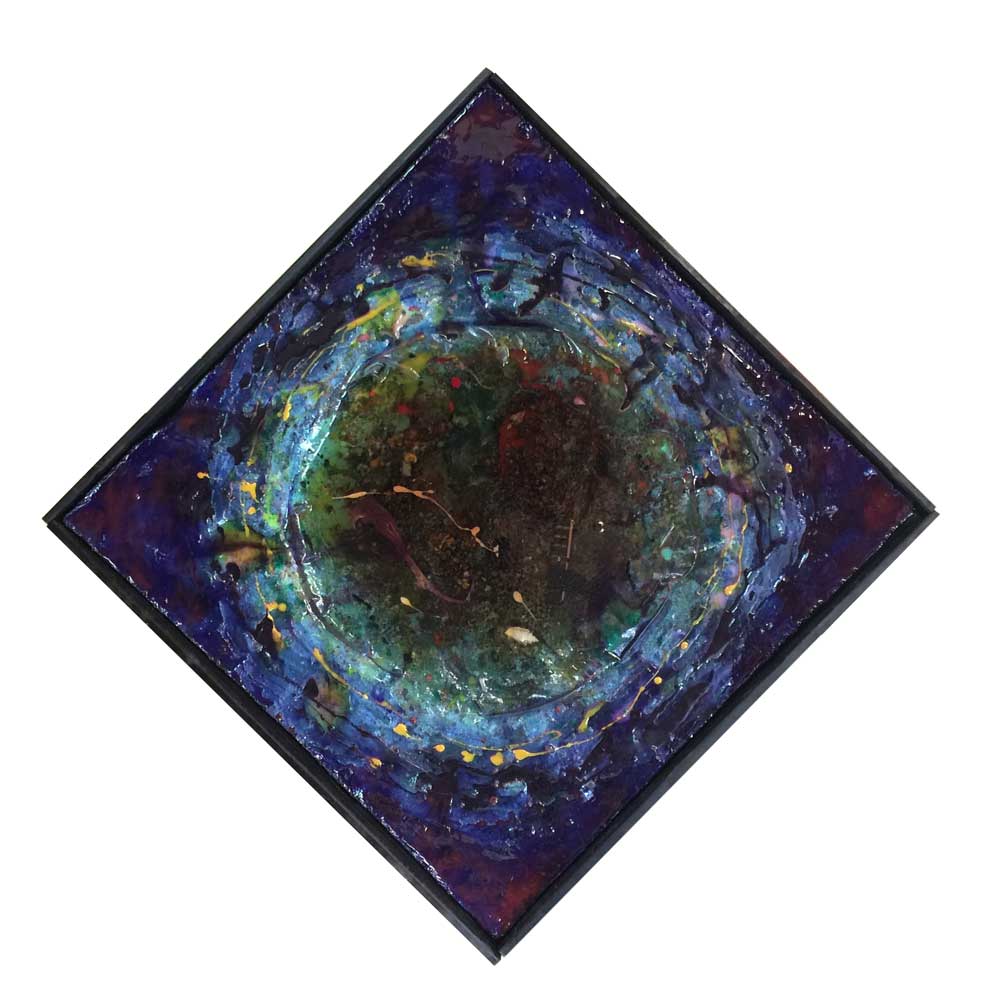現代芸術はいかなる素材からでもいかなる場所でもという行為や制作の拡張、伝統的空間の破棄ということを試み、非物資的な記号へと転換しつつあるように思われます。芸術的にモノを表現する最終的な方法とはなんでしょう?まだ見ぬ最高の芸術作品とは、それはどこにでも存在できる「真なる存在」かもしれません。そんな非物質可へ向かうためには芸術の言語化へと向かいました。コンセプチュアルアートの様式に制作行為は意味を失いました。本当にそうでしょうか?人為として制作の形式・様式という在り方、芸術であると理解できる範囲などを考えることで見逃してしまうものがあります。 あらためて考えます。作品には表現すべき芸術家の純粋意図やアイデアがあります。それは時に霊感として舞い降りてくるものです。芸術家が感じ表現したくなる動機とはどこからやってくるのでしょう?芸術家が鑑賞者に伝えようとする感覚や感情の表現の背後には、その個人を構成してきた思想や世界の存在があります。作品制作という運動には表現技術、美的な力が必要です。たとえば、美しい演奏に接したときの喜びを思い出します。すばらしい演奏には鍛えられたテクニックを感じますが、実際はそれ以上のものがあります。楽譜の裏側のものです。大作曲家は楽譜以上の「みえないもの」を、刻みつけています。設計図としての物理的な表現形式の様式はみえるところのものです。表現形式の素晴らしさ、発達の裏側に隠れたものを忘れてはなりません。それは確かに非物質的な感覚で、言語表現による芸術作品、文学も同様です。「みえないもの」を審美的に語り、読者はその発見を共感する。形式の多様性は結果であって、問題は芸術作品に潜む「みえないもの」、その背後に潜む何物かへの眼差しです。人間の存在とその精神は自然の賜で、生活様式の発展の裏側には変わらぬ存在の在り方があります。 作品は自分の人生とオーバーラップするからこそ、何かが重なり合うから存在できる。私にとって見えないもの表現とは結局、造形でありフォルムの探求となります。フォルムや記号、象徴などと表裏一体の「みえないもの」が美しく結晶させたいが為の造形の探求。フッサールは芸術作品を現象学的還元されていると言っています。私にとってそれは日常生活の片隅に存在できる作品です。当然、その可能性は無限です。なぜなら作品化される以前の「みえないもの(physis)」とは無限の力だからです。 |
・ SAKAMOT0 's GALLERY ・  「null in a circle」 2016 |
I'm following invisible nature.It is physis. The word"φύσις"(physis) is the Greek term meaning"nature", derived from the Greek word φυεσθαι(verb,"become, generate, produce"). It also had an important meaning for the Greek as"fundamental principle". Ancient Greek philosophers tried to explain this world by using dualism of"physis"and"nomos". We may say that the concept"nomos"provided strength to promote civilizations, expand and create the foundation on human value in the course of the history. A famous German philosopher Martin Heidegger said that"physis"would signify the generation of nature or the root and cause of all things in the world. According to Heidegger, Platonism was an exotic thought from the very beginning and the theory of ideas of Plato was profoundly affected by Pythagorean (and its mathematical) view of the world."Idea", which we could say the permanent, complete, unchangeable, etc., was not an existence in its general term, but"Was-sein"interpreted philosophically as"what it is"or" essentia". On the other hand, Aristotle proposed his thought that the essence of the individual lies in its"existentia". The history of metaphysics began in this way, but the crucial point is that in fact, these two concept, essentia and existentia, made a pair, and setting up this conceptual distinction we were led to cover up more fundamental"ontological difference". However, it should be noted that"Vorsokratiker"(Pre-Socratic philosophers) would discuss"nature"that they recognized before this covering up was set ,or"physis"as the existence in itself . It seems to me that modern art has tried to expand the way of production so that artists create their works anywhere and with any materials, to abandon the traditional space, and to transform modern art in itself into just immaterial symbols. What is the last way left for us to give expression to our artistic ideas? The ultimate work of art which we have not ever seen might be ubiquitous"true entity". Moreover, people say that while artists moved toward verbalizing artistic activities in line with dematerializing objects, the act of creating a work of art lost its significances along with the prevalence of conceptual art. But are these arguments really valid? Probably there is something that we might overlook by paying attention to the way and form of art production by human, and examin- ing to what extent we can accept something as a work of art. I want to reconsider these arguments. Every work of art involves a genuine intention and idea that an artist want to portray. It sometimes comes down into his mind through a kind of inspiration. Where do an artist gain motivation to his creative activities? There are some thoughts that constitute the artist and his perspectives of the world. We artists need to have the art of expression and aesthetic sense for creative activity. Let me take an example. When we listen to a brilliant performance in a concert, we can receive great pleasure from it. But in fact we also get much more than that. We acquire something more than the music score in front of me. Great composers in the past did inscribe something"invisible"in his musical works, which was different from just a music score. We recognize a design or blueprint as a form of physical expression of their artistic ideas, but it is only a"visible"thing. Instead, we might overlook outstanding skill hidden behind the particular form of expression and artistic development. To put it another, it is something immaterial to be felt and such is the case with the field of literature, an art work with language. While writers talk of an"invisible"thing aesthetically, readers sympathize with their new finding. We may see various forms of expression in a work of art, but it is only the result. The most important is, as said before, the"invisible"or what we look at through our eyes behind the visible. The existence of humans and their minds are a gift from nature, and the form of existence remains unchanged behind development of our various forms of life. Works can exist because they are somehow coupled with artists'life. To express what we cannot see on the surface, artists pursue a form or design for their thoughts, in other words, seek a form of expression in which various signs and symbols are beautifully unified with their ideas. As German philosopher, E. Husserl once said, a work of art is obtained by phenomenological reductions. In my view, it exists in the corner of our daily life. It is not so surprising if we say the possibilities to create artworks are unlimited, because the" invisible""( physis"in a philosophical term) before taking shape has unlimited possibilities. |
|
